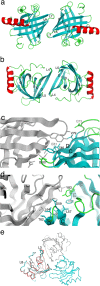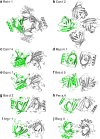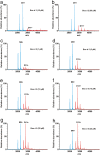Dimerization of lipocalin allergens
- PMID: 26346541
- PMCID: PMC4561914
- DOI: 10.1038/srep13841
Dimerization of lipocalin allergens
Abstract
Lipocalins are one of the most important groups of inhalant animal allergens. The analysis of structural features of these proteins is important to get insights into their allergenicity. We have determined two different dimeric crystal structures for bovine dander lipocalin Bos d 2, which was earlier described as a monomeric allergen. The crystal structure analysis of all other determined lipocalin allergens also revealed oligomeric structures which broadly utilize inherent structural features of the β-sheet in dimer formation. According to the moderate size of monomer-monomer interfaces, most of these dimers would be transient in solution. Native mass spectrometry was employed to characterize quantitatively transient dimerization of two lipocalin allergens, Bos d 2 and Bos d 5, in solution.
Conflict of interest statement
M.N., J.J. and J.R. are shareholders of Desentum Oy. The rest of the authors declare that they have no relevant conflicts of interest.
Figures






Similar articles
-
Structural aspects of dog allergies: the crystal structure of a dog dander allergen Can f 4.Mol Immunol. 2014 Sep;61(1):7-15. doi: 10.1016/j.molimm.2014.04.003. Epub 2014 May 21. Mol Immunol. 2014. PMID: 24859823
-
Important animal allergens are lipocalin proteins: why are they allergenic?Int Arch Allergy Immunol. 1999 Dec;120(4):247-58. doi: 10.1159/000024277. Int Arch Allergy Immunol. 1999. PMID: 10640908 Review.
-
Animal-derived lipocalin allergens exhibit immunoglobulin E cross-reactivity.Clin Exp Allergy. 2008 Feb;38(2):374-81. doi: 10.1111/j.1365-2222.2007.02895.x. Epub 2007 Dec 7. Clin Exp Allergy. 2008. PMID: 18070162
-
Structural similarities of human and mammalian lipocalins, and their function in innate immunity and allergy.Allergy. 2016 Mar;71(3):286-94. doi: 10.1111/all.12797. Epub 2015 Nov 23. Allergy. 2016. PMID: 26497994 Free PMC article. Review.
-
Transient dimers of allergens.PLoS One. 2010 Feb 5;5(2):e9037. doi: 10.1371/journal.pone.0009037. PLoS One. 2010. PMID: 20140203 Free PMC article.
Cited by
-
Role of Small Molecule Ligands in IgE-Mediated Allergy.Curr Allergy Asthma Rep. 2023 Sep;23(9):497-508. doi: 10.1007/s11882-023-01100-2. Epub 2023 Jun 23. Curr Allergy Asthma Rep. 2023. PMID: 37351723 Free PMC article. Review.
-
CD45 exclusion- and cross-linking-based receptor signaling together broaden FcεRI reactivity.Sci Signal. 2018 Dec 18;11(561):eaat0756. doi: 10.1126/scisignal.aat0756. Sci Signal. 2018. PMID: 30563863 Free PMC article.
-
Furry Animal Allergy: Lipocalins, Serum Albumins, and Secretoglobins-Cross-Reactivity, Diagnosis, and Management Strategies.Clin Rev Allergy Immunol. 2025 Jul 30;68(1):75. doi: 10.1007/s12016-025-09086-7. Clin Rev Allergy Immunol. 2025. PMID: 40739451 Free PMC article. Review.
-
Structural characteristics of lipocalin allergens: Crystal structure of the immunogenic dog allergen Can f 6.PLoS One. 2019 Sep 16;14(9):e0213052. doi: 10.1371/journal.pone.0213052. eCollection 2019. PLoS One. 2019. PMID: 31525203 Free PMC article.
-
Allergies to Allergens from Cats and Dogs: A Review and Update on Sources, Pathogenesis, and Strategies.Int J Mol Sci. 2024 Sep 29;25(19):10520. doi: 10.3390/ijms251910520. Int J Mol Sci. 2024. PMID: 39408849 Free PMC article. Review.
References
-
- Gould H. J. & Sutton B. J. IgE in allergy and asthma today. Nature Rev. Immunol. 8, 205–217 (2008). - PubMed
-
- Virtanen T., Kinnunen T. & Rytkönen-Nissinen M. Mammalian lipocalin allergens—insights into their enigmatic allergenicity. Clin. Exp. Allergy 42, 494–504 (2012). - PubMed
-
- Hilger C. et al. IgE-mediated anaphylaxis caused by bites of the pigeon tick Argas reflexus: Cloning and expression of the major allergen Arg r 1. J. Allergy Clin. Immunol. 115, 617–622 (2005). - PubMed
Publication types
MeSH terms
Substances
Associated data
- Actions
- Actions
LinkOut - more resources
Full Text Sources
Other Literature Sources

